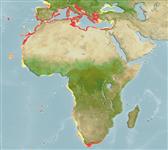分類 / Names
共通名の | 類義語 | Catalog of Fishes(部類, 種) | ITIS | CoL | WoRMS | Cloffa
>
Eupercaria/misc (Various families in series Eupercaria) >
Sparidae (Porgies)
Etymology: Diplodus: Greek, diploos = twice + Greek, odous = teeth (Ref. 45335).
Environment: milieu / climate zone / depth range / distribution range
生態学
海 底生の漂泳性; 海洋回遊性 (Ref. 51243); 深さの範囲 0 - 160 m, usually 0 - 30 m (Ref. 13780). Subtropical; ? - 25°C (Ref. 130592); 50°N - 40°S, 26°W - 36°E
Eastern Atlantic: Bay of Biscay to Cape Verde and the Canary Islands including the Mediterranean and Black Sea (off Bulgaria); also from Angola to South Africa.
Length at first maturity / サイズ / 重さ / 年齢
Maturity: Lm 16.6 range ? - ? cm
Max length : 45.0 cm TL オス/雌雄の選別がない; (Ref. 3397); common length : 22.0 cm TL オス/雌雄の選別がない; (Ref. 3397); 最大公表体重: 1.3 kg (Ref. 40637)
A euryhaline species inhabiting rocky and sometimes sandy bottoms to depths of 160 m, but more commonly in less than 50 m. The young are sometimes found in seagrass beds. Adults feed on crustaceans, worms and mollusks (Ref. 3688). Important food fish.
Life cycle and mating behavior
成熟 | 繁殖 | 放精 | 卵 | 生産力 | 幼生
Potentially hermaphroditic (Ref. 4781).
Bauchot, M.-L. and J.-C. Hureau, 1990. Sparidae. p. 790-812. In J.C. Quero, J.C. Hureau, C. Karrer, A. Post and L. Saldanha (eds.) Check-list of the fishes of the eastern tropical Atlantic (CLOFETA). JNICT, Lisbon; SEI, Paris; and UNESCO, Paris. Vol. 2. (Ref. 3688)
IUCNのレッドリストの状況は (Ref. 130435: Version 2024-2)
Human uses
水産業: 商業; ゲームフィッシュ: はい; 水族館・水槽: 商業
用具
特記事項
XMLをダウンロードして下さい
インターネットの情報源
Estimates based on models
Preferred temperature (Ref.
123201): 15.9 - 21.6, mean 18.8 °C (based on 248 cells).
Phylogenetic diversity index (Ref.
82804): PD
50 = 0.5000 [Uniqueness, from 0.5 = low to 2.0 = high].
Bayesian length-weight: a=0.01230 (0.01098 - 0.01378), b=3.05 (3.03 - 3.07), in cm total length, based on LWR estimates for this species (Ref.
93245).
栄養段階 (Ref.
69278): 3.5 ±0.1 se; based on diet studies.
Generation time: 4.3 (2.8 - 5.5) years. Estimated as median ln(3)/K based on 16
growth studies.
回復力 (Ref.
120179): 手段, 1.4年~4.4年の倍増期間の最小個体群 (K=0.26-0.4; tmax=6; tm=2).
Fishing Vulnerability (Ref.
59153): Low to moderate vulnerability (33 of 100).
Climate Vulnerability (Ref.
125649): Low vulnerability (23 of 100).
Nutrients (Ref.
124155): Calcium = 49.2 [25.2, 92.2] mg/100g; Iron = 0.766 [0.416, 1.387] mg/100g; Protein = 18.8 [17.8, 19.7] %; Omega3 = 0.345 [0.189, 0.641] g/100g; Selenium = 29.6 [13.1, 62.5] μg/100g; VitaminA = 24.3 [6.3, 92.6] μg/100g; Zinc = 0.919 [0.627, 1.322] mg/100g (wet weight); based on
nutrient studies.
